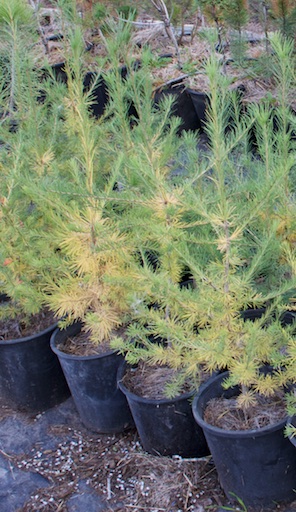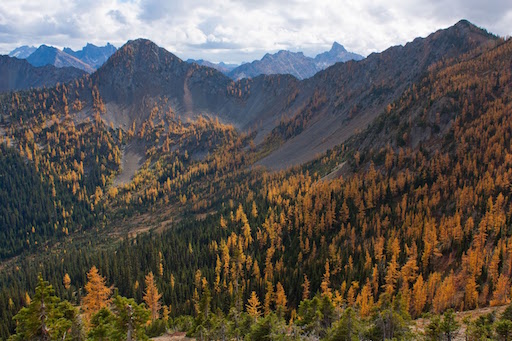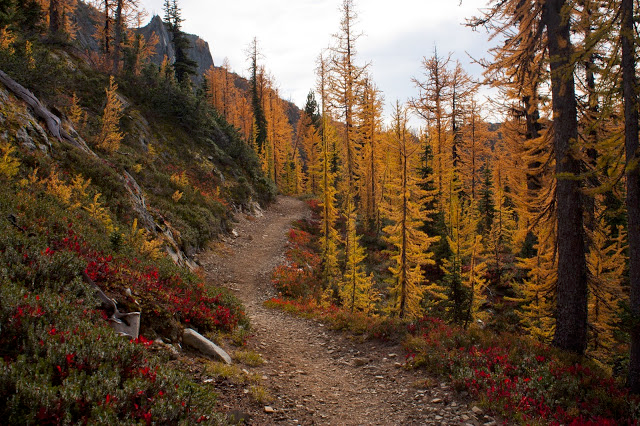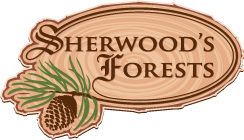
Commonly Western Larch will grow in mixed stands, usually mixed with spruce and fir. When it grow with doug fir or pines, it quickly outgrows them, and shades them out. But on occasion you will find mixed stands when fire hit at the right time and place. That said, it prefers open sunny areas

These guys have survived 2 winters now. They are a bit over 2 feet tall. This shot was taken in mid September. Some are starting to change colour.

This pic, shamelessly snagged from Lady Nomad's blog, shows how large they can get. That trunk is somewhere between 8 and 10 feet in diameter. Bark can be up to 18" thick at the trunk giving this tree resistance to all but the most severe forest fire. I do NOT recommend this tree for a city lot.
Western Larch
Larix occidentalis
This is experimental here on the prairies. My first reading of western larch told me it wouldn't work here on the prairies. It's managed three winters so far. (2021)
It's native to the mountains in interior BC, and the more southern foothills of the eastern slopes in Alberta., and grows quite a ways up those slopes, but I didn't see it on the valley floor. I suspect that it doesn't compete with grass as a seedling.
Lesson learned: Don't plant it in a frost pocket.
The soils where it grows are usually well drained. It's likely to be less tolerant of heavy clay soils, especially when those soils are flat and slow to dry in spring.
Lesson: Plant on a slope, or on gravely sandy soils.
Ok, so why plant it. Visually it is very similar to Siberian Larch.
It grow faster, and gets larger. How big? Up to 70 meters tall. Up to 850 years old.
It's also more prone to shedding lower branches as it ages, particularly in close spacing. Along with the heavy bark at maturity it resists fire. In a more open setting it will have branches to the ground. If you want a "fire safe" tree, prune it up to be above flame height of the understory.
The needles form a heavy carpet below the tree. They are not very acidic, so grass easily grows through the needle layer the following spring.

Larch at timberline. This is in the Northern Cascades. Yes, Washington State is south of us and a lot warmer. But this is close to 7000 feet.

This is near the upper end of their range. Kind of ratty looking. this is a north slope, so they don't get as much sun. Should do better with regular care and full sun.
Guidelines
Features:
- Needle tree that goes through seasonal changes like a leaf tree.
- BRIGHT yellow fall colour.
- Open shade permits growing other things below them.
- Does best on moist well drained soils. Drought tolerant.
- Deep roots resist wind throw. (I don't think I've ever seen a wind toppled larch)
- Fabulous climbing tree.
Zone: Zone 4, based on where I've seen it grow, Oregon State University; I've seen reports of zone 2 (Plants for a future) I suspect spring frost is the biggest threat to use on the prairies.
Size: 100 to 180 feet tall by 20 to 30 feet wide.
Growth rate: Fast. Trees easily reach 100 feet in 50 years.
Soil: Likes moist deep well drained soils. Tolerates the high calcium/magnesium soils we have on the prairies. Tolerates poor soils.
Water Where it grows natively it typically gets 25-30 inches of precipitation per year. In the southern end of it's range it will grow only on the north slope, where at the north end, it grows on both north and south slopes. I think the south slope at southern latitudes is too dry. These same slopes also don't have spruce, which is a common co-dominant tree. Generally tolerates moderately dry to moist soils.
Sun: Full sun preferred. Tolerates some shade.
Water: During first year. Drought tolerant. Water when top 2 inches of soil are dry, and water deeply. Should only need to be watered 3-4 times. If you continue to water you will get faster growth, but continue to water deeply when you do.
More info: Western Larch -- USFS Silvics Manual
Got something to say? Email me: sfinfo@sherwoods-forests.com
Interesting? Share this page.
Want to talk right now? Call me: (8 am to 8 pm only, please) 1-780-848-2548
Do not arrive unannounced. Phone for an appointment. Why? See Contact & Hours That same page gives our hours of operation.
Back to Top
Copyright © 2008 - 2021 S. G. Botsford
Sherwood's Forests is located about 75 km southwest of Edmonton, Alberta. Please refer to the map on our Contact page for directions.
